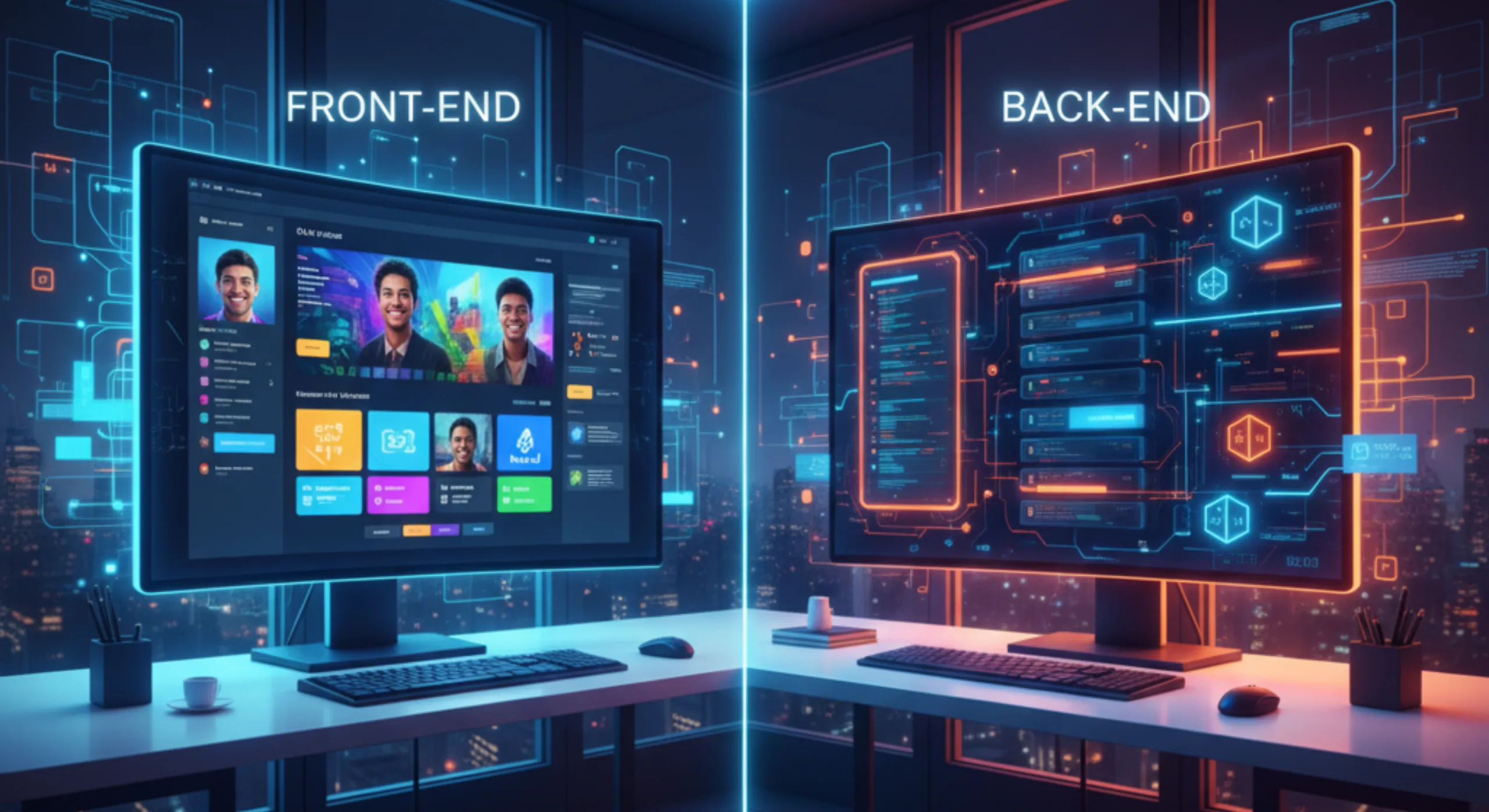Front-End vs. Back-End Development: Which One Actually Builds Your Site?

When you open a website, the first thing you notice is the way it looks, how smooth it feels, and whether the design makes sense. But behind that smooth experience lies a lot of unseen effort that most people don’t even think about. In the world of web development, there are two sides to the story: Front-End Development and Back-End Development. Both are equally important, but in very different ways. It’s a bit like a cricket match the batsmen score runs in front of everyone, but without the bowlers and fielders doing their job, the team can’t win.
In this blog, we’ll break down the difference between the two, why they matter, and which one actually builds your site. Whether you’re a student, a budding developer, or even a business owner trying to make sense of the digital space, this comparison will give you clarity.
What Exactly Is Front-End Development?
Front-End Development is all about what the user sees and interacts with. Think of it as the “face” of the website. It involves designing and coding the layout, colors, fonts, buttons, images, menus, and overall structure. In short, if you can click it, see it, or scroll through it that’s the front end.
Front-End developers usually work with languages like HTML, CSS, and JavaScript. Today, popular frameworks like React, Angular, and Vue.js make it easier to build dynamic and responsive websites that look good on every screen, from a large desktop monitor to a small mobile phone.
Imagine walking into a restaurant. The ambiance, the lighting, the way the menu is presented, and even the plates used all of that is the “front end” of your dining experience. Without it, even if the food is world-class, you won’t enjoy the meal fully.
What Is Back-End Development Then?
Back-End Development is everything that happens behind the scenes. It is the backbone, the kitchen of that same restaurant. You don’t see it directly, but it is the engine that keeps the whole thing running.
Back-End developers work with databases, servers, and application logic. Their job is to ensure that when you click a button on a website, something meaningful happens in response. For example, when you log into your bank’s website, it is the back end that checks your details in the database and shows your account balance.
Technologies here include programming languages like Python, Java, PHP, Ruby, or frameworks like Node.js, Django, and Spring Boot. Databases like MySQL, MongoDB, or PostgreSQL are also part of the back-end toolkit.
In short, the back end takes care of how things work, while the front end takes care of how things look and feel.
The Key Differences at a Glance
Front-End Development
- Focus: User interface and overall experience.
- Languages & Tools: HTML, CSS, JavaScript, React, Angular.
- Main Job: Designing layouts, building responsive pages, handling user interactions.
- User Interaction: Directly visible and felt by users.
- Example: The “Buy Now” button on Amazon.
Back-End Development
- Focus: Server-side logic, databases, and application processes.
- Languages & Tools: Python, Java, PHP, Node.js, Ruby.
- Main Job: Managing data, building APIs, ensuring functionality and security.
- User Interaction: Hidden from users, experienced only through results.
- Example: Processing payment and updating the order after you click “Buy Now.”
Which One Actually Builds Your Site?
Now comes the big question: who really builds your website the front end or the back end? The honest answer is both. Without Front-End Development, you will have a website that nobody can use or even understand. Without Back-End Development, you will have a pretty shell with no real functionality.
It’s like having a car. The design, seats, dashboard, and paintwork are the front end. The engine, gears, and fuel system are the back end. You need both for the car to move.
That said, in today’s fast-paced digital world, many small businesses and startups first focus on the front end, because the look and feel of a website is what convinces customers to stay and explore. A strong front end can give your website that “wow” factor and make people trust your brand. But without a reliable back end, things like payments, user accounts, and data storage would collapse.
Why Front-End Development Gets More Spotlight
There’s a reason why Front-End Development often becomes the buzzword. Users directly interact with it. A slow, clunky, or badly designed site will drive people away, no matter how powerful your back end is. Research shows that users decide within a few seconds whether they’ll stay on a site or leave. That decision is 100% based on the front end.
In India, we often say, “Pehla prabhav hi antim prabhav hota hai” (the first impression is the last impression). That holds true online as well. A visually pleasing and smooth front end can make or break the deal for businesses.
Common Tools and Skills in Front-End Development
If you’re planning to start your journey in this field, here’s what you need to focus on:
- HTML5: The skeleton of the site.
- CSS3: For styling, colors, and layouts.
- JavaScript: To make your site interactive.
- Responsive Design: Ensuring the site works on mobile, tablet, and desktop.
- Frameworks: React, Angular, Vue.js for advanced projects.
- UI/UX Basics: Knowing how users behave online and designing accordingly.
Front-End developers also need an eye for detail, creativity, and the ability to balance beauty with practicality.
Back-End Development Essentials
To be fair, the back end deserves equal respect. Here’s what back-end developers usually master:
- Server-Side Languages: Python, PHP, Java, Node.js.
- Databases: MySQL, MongoDB, PostgreSQL.
- APIs: To connect front-end with back-end services.
- Security Measures: Protecting user data from hackers.
- Performance Optimization: Making sure the site loads fast even with thousands of users.
Front-End Development Careers in India
The demand for Front-End Development in India has skyrocketed. With startups mushrooming and even traditional businesses moving online, everyone wants websites that look sharp and run smooth.
Job titles you’ll often see are:
- Front-End Developer
- UI Developer
- Web Designer + Developer
- React Developer
Salary packages vary, but skilled front-end developers in metro cities can easily earn between ₹6–12 lakhs per year, and even more with experience or international projects. Many freelancers in India also earn well by building websites for clients across the globe.
So, Which Path Should You Choose?
If you love design, visuals, and the “artistic” side of coding, then Front-End Development is your arena. You’ll be building the part that users directly interact with. But if you enjoy solving puzzles, working with data, and building strong systems, then back-end might be your cup of tea.
Of course, there’s also a middle path Full-Stack Development where you handle both sides. Full-stack developers are highly valued in the market because they can see the bigger picture and deliver complete solutions.
The Future of Web Development
Technology never stands still. Front-End Development is moving towards more immersive experiences with AR/VR, voice interactions, and AI-driven personalization. Back-End Development is adopting cloud computing, microservices, and advanced security.
For students and professionals, the real trick is to keep learning. Today’s React may be tomorrow’s history. Staying updated is the only way to remain relevant in this ever-changing industry.
Final Thoughts
At the end of the day, asking “Which one actually builds your site front end or back end?” is like asking “Which is more important, the heart or the face?” The truth is, you need both to survive and succeed. Still, if you’re just starting out, focusing on Front-End Development is often the best first step. It gives you quick results, visible outputs, and the confidence to move ahead. Later, you can always dive into back-end or even full-stack.
Remember, every great website you use daily whether it’s Amazon, Flipkart, Swiggy, or Zomato stands tall only because of the teamwork between front-end and back-end. One handles the show, the other handles the engine. Together, they build the web as we know it.
If you’re serious about turning your website into a real growth engine not just a digital brochure, Contact Ozrit for Website Development
